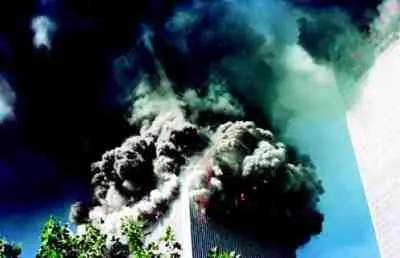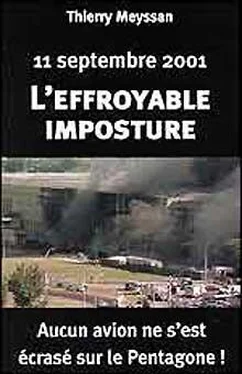Тьерри Мейссан - 11 сентября 2001
Здесь есть возможность читать онлайн «Тьерри Мейссан - 11 сентября 2001» весь текст электронной книги совершенно бесплатно (целиком полную версию без сокращений). В некоторых случаях можно слушать аудио, скачать через торрент в формате fb2 и присутствует краткое содержание. Город: Москва, Год выпуска: 2002, Издательство: Карно, Жанр: Публицистика, на русском языке. Описание произведения, (предисловие) а так же отзывы посетителей доступны на портале библиотеки ЛибКат.
- Название:11 сентября 2001
- Автор:
- Издательство:Карно
- Жанр:
- Год:2002
- Город:Москва
- ISBN:нет данных
- Рейтинг книги:5 / 5. Голосов: 1
-
Избранное:Добавить в избранное
- Отзывы:
-
Ваша оценка:
- 100
- 1
- 2
- 3
- 4
- 5
11 сентября 2001: краткое содержание, описание и аннотация
Предлагаем к чтению аннотацию, описание, краткое содержание или предисловие (зависит от того, что написал сам автор книги «11 сентября 2001»). Если вы не нашли необходимую информацию о книге — напишите в комментариях, мы постараемся отыскать её.
марионеточном, характере политической науки в России.
11 сентября 2001 — читать онлайн бесплатно полную книгу (весь текст) целиком
Ниже представлен текст книги, разбитый по страницам. Система сохранения места последней прочитанной страницы, позволяет с удобством читать онлайн бесплатно книгу «11 сентября 2001», без необходимости каждый раз заново искать на чём Вы остановились. Поставьте закладку, и сможете в любой момент перейти на страницу, на которой закончили чтение.
Интервал:
Закладка:
In early October, large cracks were observed along Liberty Street, indicating that the south wall had started to move into the failed area under the influence of the lateral earth pressures. Mueser-Rutledge Engineers were retained to review the situation and make suitable recommendations. As a temporary measure, sand fill was backfilled against the inside face of the south wall to counterbalance earth pressures on the unexcavated side. Following temporary stabilization of the wall, tiebacks were reinstalled through the wall in a manner similar to that used to stabilize the excavation during the original construction of the development. After these tiebacks were installed, it was possible to begin excavation of the temporary sand backfill and the accumulated debris. Tiebacks were similarly installed at the other exterior substructure walls to provide lateral support as the damaged slabs and debris were excavated and removed from the site.
2.3 Observations and Findings
The structural damage sustained by each of the two buildings as a result of the terrorist attacks was massive. The fact that the structures were able to sustain this level of damage and remain standing for an extended period of time is remarkable and is the reason that most building occupants were able to evacuate safely. Events of this type, resulting in such substantial damage, are generally not considered in building design, and the ability of these structures to successfully withstand such damage is noteworthy.
Preliminary analyses of the damaged structures, together with the fact the structures remained standing for an extended period of time, suggest that, absent other severe loading events such as a windstorm or earthquake, the buildings could have remained standing in their damaged states until subjected to some significant additional load. However, the structures were subjected to a second, simultaneous severe loading event in the form of the fires caused by the aircraft impacts.

Figure 2-32 The top portion of WTC 2 falls to the east, then south, as viewed from the northeast.
The large quantity of jet fuel carried by each aircraft ignited upon impact into each building. A significant portion of this fuel was consumed immediately in the ensuing fireballs. The remaining fuel is believed either to have flowed down through the buildings or to have burned off within a few minutes of the aircraft impact. The heat produced by this burning jet fuel does not by itself appear to have been sufficient to initiate the structural collapses. However, as the burning jet fuel spread across several floors of the buildings, it ignited much of the buildings' contents, causing simultaneous fires across several floors of both buildings. The heat output from these fires is estimated to have been comparable to the power produced by a large commercial power generating station. Over a period of many minutes, this heat induced additional stresses into the damaged structural frames while simultaneously softening and weakening these frames. This additional loading and the resulting damage were sufficient to induce the collapse of both structures.
Because the aircraft impacts into the two buildings are not believed to have been sufficient to cause collapse without the ensuing fires, the obvious question is whether the fires alone, without the damage from the aircraft impact, would have been sufficient to cause such a collapse. The capabilities of the fire protection systems make it extremely unlikely that such fires would develop without some unusual triggering event like the aircraft impact. For all other cases, the fire protection for the tower buildings provided in-depth protection. The first line of defense was the automatic sprinkler protection. The sprinkler system was intended to respond quickly and automatically to extinguish or confine a fire. The second line of defense consisted of the manual (FDNY/Port Authority Fire Brigade) firefighting capabilities, which were supported by the building standpipe system, emergency fire department use elevators, smoke control system, and other features. Manual suppression by FDNY was the principal fire protection mechanism that controlled a large fire that occurred in the buildings in 1975. Finally, the last line of defense was the structural fire resistance. The fire resistance capabilities would not be called upon unless both the automatic and manual suppression systems just described failed. In the incident of September 11, not only did the aircraft impacts disable the first two lines of defense, they also are believed to have dislodged fireproofing and imposed major additional stresses on the structural system.
Had some other event disabled both the automatic and manual suppression capabilities and a fire of major proportions occurred while the structural framing system and its fireproofing remained intact, the third line of defense, structural fireproofing, would have become critical. The thickness and quality of the fireproofing materials would have been key factors in the rate and extent of temperature rise in the floor trusses and other structural members. In the preparation of this report, there has not been sufficient analysis to predict the temperature and resulting change in strength of the individual structural members in order to approximate the overall response of the structure. Given the redundancy in the framing system and the capability of that system to redistribute load from a weakened member to other parts of the structural system, it is impossible, without extensive modeling and other analysis, to make a credible prediction of how the buildings would have responded to an extremely severe fire in a situation where there was no prior structural damage. Such simulations were not performed within the scope of this study, but should be performed in the future.
Buildings are designed to withstand loading events that are deemed credible hazards and to protect the public safety in the event such credible hazards are experienced. Buildings are not designed to withstand any event that could ever conceivably occur, and any building can collapse if subjected to a sufficiently extreme loading event. Communities adopt building codes to help building designers and regulators determine those loading events that should be considered as credible hazards in the design process. These building codes are developed by the design and regulatory communities themselves, through a voluntary committee consensus process. Prior to September 11, 2001, it was the consensus of these communities that aircraft impact was not a sufficiently credible hazard to warrant routine consideration in the design of buildings and, therefore, the building codes did not require that such events be considered in building design. Nevertheless, the design of WTC 1 and WTC 2 did include at least some consideration of the probable response of the buildings to an aircraft impact, albeit a somewhat smaller and slower moving aircraft than those actually involved in the September 11 events. Building codes do consider fire as a credible hazard and include extensive requirements to control the spread of fire throughout buildings, to delay the onset of fire-induced structural collapse, and to facilitate the safe egress of building occupants in a fire event. For fire-protected steel-frame buildings, like WTC 1 and WTC 2, these code requirements had been deemed effective and, in fact, prior to September 11, there was no record of the fire-induced-collapse of such structures, despite some very large uncontrolled fires.
The ability of the two towers to withstand aircraft impacts without immediate collapse was a direct function of their design and construction characteristics, as was the vulnerability of the two towers to collapse a result of the combined effects of the impacts and ensuing fires. Many buildings with other design and construction characteristics would have been more vulnerable to collapse in these events than the two towers, and few may have been less vulnerable. It was not the purpose of this study to assess the code conformance of the building design and construction, or to judge the adequacy of these features. However, during the course of this study, the structural and fire protection features of the buildings were examined. The study did not reveal any specific structural features that would be regarded as substandard, and, in fact, many structural and fire protection features of the design and construction were found to be superior to the minimum code requirements.
Читать дальшеИнтервал:
Закладка:
Похожие книги на «11 сентября 2001»
Представляем Вашему вниманию похожие книги на «11 сентября 2001» списком для выбора. Мы отобрали схожую по названию и смыслу литературу в надежде предоставить читателям больше вариантов отыскать новые, интересные, ещё непрочитанные произведения.
Обсуждение, отзывы о книге «11 сентября 2001» и просто собственные мнения читателей. Оставьте ваши комментарии, напишите, что Вы думаете о произведении, его смысле или главных героях. Укажите что конкретно понравилось, а что нет, и почему Вы так считаете.












